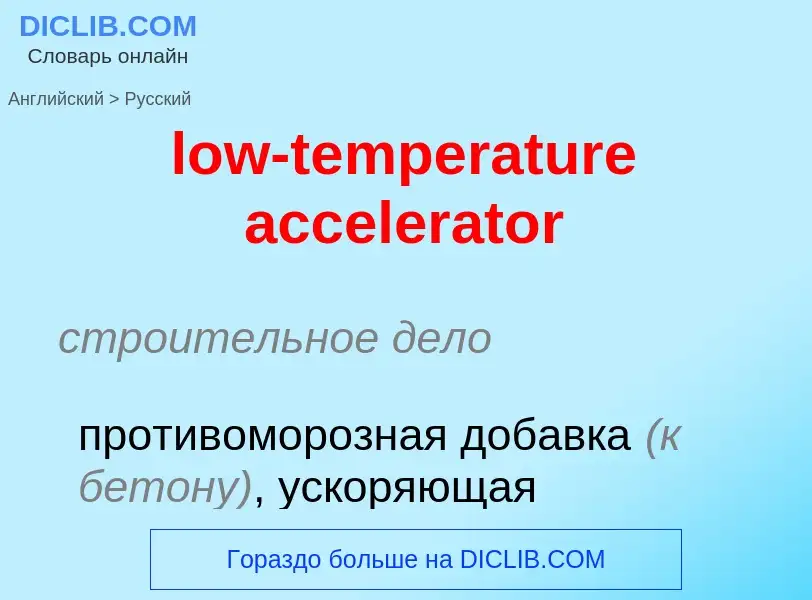Перевод и анализ слов искусственным интеллектом ChatGPT
На этой странице Вы можете получить подробный анализ слова или словосочетания, произведенный с помощью лучшей на сегодняшний день технологии искусственного интеллекта:
- как употребляется слово
- частота употребления
- используется оно чаще в устной или письменной речи
- варианты перевода слова
- примеры употребления (несколько фраз с переводом)
- этимология
low-temperature accelerator - перевод на русский
строительное дело
противоморозная добавка (к бетону), ускоряющая схватывание
общая лексика
ускоритель линейный
медицина
линейный ускоритель
Определение
Википедия

In physics, cryogenics is the production and behaviour of materials at very low temperatures.
The 13th IIR International Congress of Refrigeration (held in Washington DC in 1971) endorsed a universal definition of "cryogenics" and "cryogenic" by accepting a threshold of 120 K (or –153 °C) to distinguish these terms from the conventional refrigeration. This is a logical dividing line, since the normal boiling points of the so-called permanent gases (such as helium, hydrogen, neon, nitrogen, oxygen, and normal air) lie below 120K while the Freon refrigerants, hydrocarbons, and other common refrigerants have boiling points above 120K. The U.S. National Institute of Standards and Technology considers the field of cryogenics as that involving temperatures below -153 Celsius (120K; -243.4 Fahrenheit)
Discovery of superconducting materials with critical temperatures significantly above the boiling point of nitrogen has provided new interest in reliable, low cost methods of producing high temperature cryogenic refrigeration. The term "high temperature cryogenic" describes temperatures ranging from above the boiling point of liquid nitrogen, −195.79 °C (77.36 K; −320.42 °F), up to −50 °C (223 K; −58 °F).
Cryogenicists use the Kelvin or Rankine temperature scale, both of which measure from absolute zero, rather than more usual scales such as Celsius which measures from the freezing point of water at sea level or Fahrenheit which measures from the freezing point of a particular brine solution at sea level.


![This is a diagram of an infrared space telescope, that needs a cold mirror and instruments. One instrument needs to be even colder, and it has a cryocooler. The instrument is in region 1 and its cryocooler is in region 3 in a warmer region of the spacecraft (see [[MIRI (Mid-Infrared Instrument)]] or [[James Webb Space Telescope]]). This is a diagram of an infrared space telescope, that needs a cold mirror and instruments. One instrument needs to be even colder, and it has a cryocooler. The instrument is in region 1 and its cryocooler is in region 3 in a warmer region of the spacecraft (see [[MIRI (Mid-Infrared Instrument)]] or [[James Webb Space Telescope]]).](https://commons.wikimedia.org/wiki/Special:FilePath/ISIM 3 logical region.jpg?width=200)




.gif?width=200)
.gif?width=200)
![Steel casting undergoing x-ray using the linear accelerator at [[Goodwin Steel Castings Ltd]] Steel casting undergoing x-ray using the linear accelerator at [[Goodwin Steel Castings Ltd]]](https://commons.wikimedia.org/wiki/Special:FilePath/Linear Accelerator.jpg?width=200)
